History of the Amish (Part 5)
By Magda Adriana
January 1, 2024

History of the Amish Series
Part 1
Part 2
Part 3
Part 4
Part 5
Part 6
Part 7
Part 8
The Church in a New World
In the first decades after Amish arrived in the New World, church life was not well organized. Settlements were being formed and migration was disturbing community and church life. New families arrived monthly while others moved westward to build from scratch. Due to constant changes, church services were infrequent in many districts. On top of this, many areas were without a minister for extended periods of time because ministers were often transient as well. Sometimes new settlements had to wait a several years before an ordained church member could lead a service. The first Amish bishop (Jacob Hertzler) arrived no earlier than 1749.
Most Amish were farmers just as they had been in Europe. Some were millers, some tanners, and one was even a folk-physician (Hans Blank, Lebanon Valley). Wheat was the chief cash crop in the eighteenth century. Other typical farm crops were flax (linen) and apples.
Fitting in and Standing Apart
Amish appreciated simplicity and modesty in dress. There are no records that a distinctive style of clothing set them apart from other German immigrants.
The Amish came as free laborers. Other immigrants who could not pay the cost of immigration came on credit. They were known as “redemptioners” and paid off their passage by working for a negotiated number of years. Even though the Amish were not wealthy, they practiced mutual aid. There are no records of any Amish who had to work as redemptioners after arriving in the New World. This was one of the reasons Amish communities grew, flourished, and thrived economically, though it was not always easy. Just as Amish valued their freedom, they also respected the freedom of others. Unlike some of the people surrounding them, the Amish did not own slaves.
Suffering Violence
in the New World
The Amish could practice their faith in an abundance of freedom in the New World. However, they still had to deal with violence. French and English soldiers were fighting about colony borders during the Seven Years’ War. Native Americans often sided with the French and attacked anyone who lived in or near English settlements. William Penn had invited Anabaptist groups to migrate to Pennsylvania, but he and other British attackers made no difference between Amish and non-Amish. Households faced violence and insecure living in bordering areas.
Until that time, Pennsylvania had been a pacifist province. The government now wanted to form an army to defend against attacking bands. They initiated a militia and began funding military defence. The Amish and Mennonite “peace churches” appealed for exemption from this program. They were not forced to go against their religious beliefs, but instead, were allowed to take care of war refugees and provide other necessary services.
The Threat of Revivalism
Even though threats of persecution and being treated as second-class citizens were absent in the New World, the Amish church still faced hardships. During the 18th century the Amish church lost members to other Christian denominations.
Evangelical preachers taught that a conversion experience was essential for becoming a Christian. Amish teaching emphasized experiencing salvation by daily living the Christian life.
Both Amish and evangelicals taught salvation by grace alone and saw the necessity of daily living with Christ. For the Amish, a unique, emotional conversion experience was not essential since they believed that the fruits of one’s life were a clear testimony of their faith. Evangelicals saw the ability to testify of a clear salvation experience as necessary. They charged the Amish with dead formalism and tried to infuse their communities with a more experiential religion.
Amish and evangelicals viewed the church differently. Amish saw church in terms of community which influenced every aspect of life with accountability. The revivalists’ emphasis on individual salvation weakened the importance and authority of the church.
At that time, the cultural gap between Amish and the rest of society was not easily seen. Many young people were attracted by the teachings and lifestyles of other Christian churches and left the Amish church behind. Others left due to marriages with a spouse from another Christian church.
The German Baptist Brethren, also called “Dunkers,” attracted many Amish. They shared the revivalism of many evangelical churches, but stood close to traditional Amish values on church and community life including non-resistance and plain dress.
Despite many Amish leaning towards evangelical churches, most Amish remained faithful to the Amish church and stayed united in their beliefs, practices, and simple lifestyle.
Primary source: A History of the Amish,
by Steven M. Nolt
To be continued in next issue...
« Back to Articles






